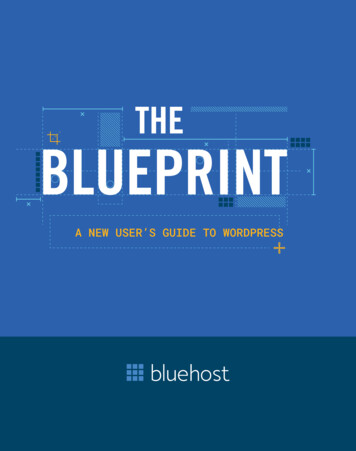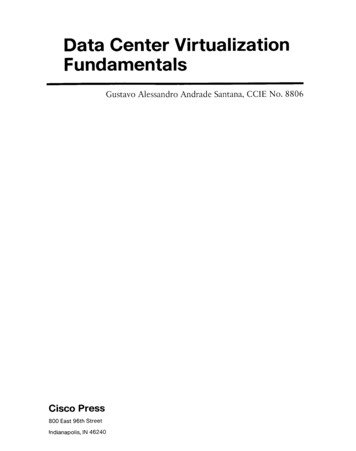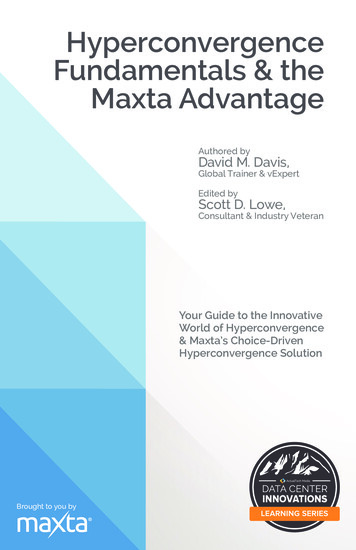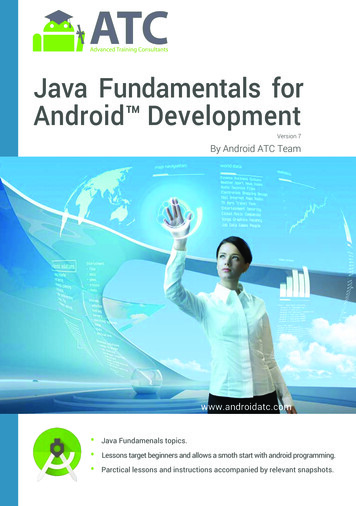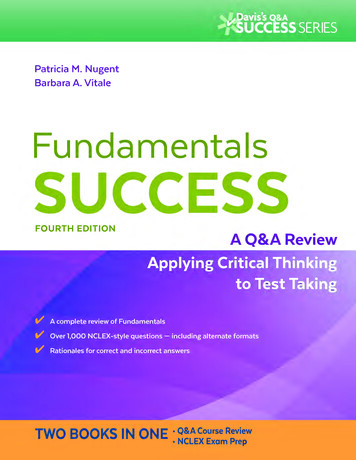
Transcription
Patricia M. NugentBarbara A. Vita IeFundamentalsFOURTH EDITIONAQ&AReviewTWO BOOKS IN ONE Q&ACourse Review NCLEX Exam Prep
Fundamentals SuccessA Q & A Review Applying Critical Thinking toTest TakingFOURTH EDITION4414 FM i-xxii.indd iProcess CyanProcess MagentaProcess YellowProcess BlackPANTONE 661 C4/17/2015 3:13:30 PM
3042 Appendix B .indd 5388/12/2014 3:02:33 PM
Fundamentals SuccessA Q & A Review Applying Critical Thinking toTest TakingFOURTH EDITIONPatricia M. Nugent, RN, MA, MS, EdDProfessor EmeritusAdjunct ProfessorNassau Community CollegeGarden City, New YorkPrivate Practice—President of Nugent Books, Inc.Barbara A. Vitale, RN, MAProfessor EmeritusNassau Community CollegeGarden City, New YorkPrivate Practice—Professional Resources for Nursing4414 FM i-xxii.indd iiiProcess CyanProcess MagentaProcess YellowProcess BlackPANTONE 661 C4/17/2015 3:13:30 PM
F. A. Davis Company1915 Arch StreetPhiladelphia, PA 19103www.fadavis.comCopyright 2015 by F. A. Davis CompanyCopyright 2015 by F. A. Davis Company. All rights reserved. This book is protected bycopyright. No part of it may be reproduced, stored in a retrieval system, or transmitted inany form or by any means, electronic, mechanical, photocopying, recording, or otherwise,without written permission from the publisher.Printed in the United States of AmericaLast digit indicates print number: 10 9 8 7 6 5 4 3 2 1Publisher, Nursing: Robert G. MartoneDirector of Content Development: Darlene D. PedersenContent Project Manager: Jacalyn C. ClayElectronic Project Editor: Sandra A. GlennieDesign and Illustration Manager: Carolyn O’BrienAs new scientific information becomes available through basic and clinical research, recommended treatments and drug therapies undergo changes. The author(s) and publisher havedone everything possible to make this book accurate, up to date, and in accord with acceptedstandards at the time of publication. The author(s), editors, and publisher are not responsible for errors or omissions or for consequences from application of the book, and makeno warranty, expressed or implied, in regard to the contents of the book. Any practicedescribed in this book should be applied by the reader in accordance with professionalstandards of care used in regard to the unique circumstances that may apply in each situation. The reader is advised always to check product information (package inserts) forchanges and new information regarding dose and contraindications before administeringany drug. Caution is especially urged when using new or infrequently ordered drugs.ISBN: 978-0-8036-4414-4Authorization to photocopy items for internal or personal use, or the internal or personaluse of specific clients, is granted by F. A. Davis Company for users registered with theCopyright Clearance Center (CCC) Transactional Reporting Service, provided that the feeof .25 per copy is paid directly to CCC, 222 Rosewood Drive, Danvers, MA 01923. Forthose organizations that have been granted a photocopy license by CCC, a separate systemof payment has been arranged. The fee code for users of the Transactional ReportingService is: 978-0-8036-4414-4/15 0 .25.4414 FM i-xxii.indd ivProcess CyanProcess MagentaProcess YellowProcess BlackPANTONE 661 C4/17/2015 3:13:30 PM
Dedicated toNeil NugentandJoseph VitaleFor their love, support, sense of humor, enthusiasm for life,and attempts to keep our compulsive natures under control.4414 FM i-xxii.indd vProcess CyanProcess MagentaProcess YellowProcess BlackPANTONE 661 C4/17/2015 3:13:30 PM
3042 Appendix B .indd 5388/12/2014 3:02:33 PM
ReviewersCynthia AaronStillman CollegeTuscaloosa, AlabamaCarol AlexanderPalm Beach State CollegeLake Worth, FloridaBonnie AllenIllinois Central CollegeEast Peoria, IllinoisCindy BakerMurray State CollegeTishoming, OklahomaCynthia BostickCalifornia State University, DominguezHillsCarson, CaliforniaCathy CoramPueblo Community College—FreemondCampusCanon, City, ColoradoKelli DavisGadsden State Community CollegeCentre, AlabamaAmanda DayAcademy of Medical and Health SciencePueblo, ColoradoDonna DexterCitizens School of NursingNew Kensington, PennsylvaniaLori EvansGreater Lowell TechTyngsboro, MassachusettsBarbara BozicevichHibbing Community CollegeHibbing, MinnesotaVesta FairleyBishop State Community CollegeMobile, AlabamaBarbara BrittonFayetteville Technical Community CollegeFayetteville, North CarolinaCris FinnRegis UniversityDenver, ColoradoChristine BrooksPalm Beach Atlantic UniversityWest Palm Beach, FloridaKaren L. FuquaSouth Texas CollegeMcAllen, TexasCatherine CastonConcordia UniversityIrvine, CaliforniaDawana GibbsCollege of Coastal GeorgiaBrunswick, GeorgiaAmy C. ChavarriaSouth Texas CollegeMcAllen, TexasSharlene GeorgesenMorningside CollegeSioux City, IowaRita CicconeOhio Valley General HospitalMcKees Rocks, PennsylvaniaGeraldine Valencia-GoCollege of New RochelleNew Rochelle, New Yorkvii4414 FM i-xxii.indd viiProcess CyanProcess MagentaProcess YellowProcess BlackPANTONE 661 C4/17/2015 3:13:30 PM
viiiFUNDAMENTALS SUCCESSLois GotesCarl Albert State CollegePoteau, OklahomaDeborah HendersonBay Path PN ProgramCharlton, MassachusettsKara HoffmanOhio Valley General HospitalMcKees Rocks, PennsylvaniaMonica HollandOklahoma City Community CollegeOklahoma City, OklahomaAnita JonesMurray State CollegeTishomingo, OklahomaSusan KarcherHarold B. and Dorothy A. SnyderSchoolsPlainfield, New JerseyJudy MaynardFayetteville Technical CommunityCollegeFayetteville, North CarolinaTammie McCoyMississippi University for WomenColumbus, MississippiVictoria NewtonNortheastern Hospital School of NursingPhiladelphia, PennsylvaniaAmanda M. ReynoldsGrambling State UniversityGrambling, LouisianaDeborah A. RobertsSonoma StateRohnert Park, CaliforniaJane RosatiDaytona State CollegeDaytona Beach, FloridaKathleen KavanaghFelician CollegeLodi, New JerseyJeffrey RossBainbridge CollegeBainbridge, GeorgiaElizabeth KaweckiSouth University West Palm BeachRoyal Palm Beach, FloridaLaura SaucerSouth University MontgomeryMontgomery, AlabamaPatricia KellySaint Xavier UniversityChicago, IllinoisBeverly SchaeferUrsuline CollegePepper Pike, OhioMaggie KingXavier UniversityCincinnati, OhioDianne ScottNorthwest Mississippi CommunityCollegeSenatobia, MississippiMary KovarnaMorningside CollegeSioux City, IowaChristine KowalCumberland UniversityLebanon, TennesseeRhonda LansdellNortheast Mississippi CommunityCollegeBooneville, MississippiTracy LopezDona Ana Community CollegeLas Cruces, New Mexico4414 FM i-xxii.indd viiiProcess CyanProcess MagentaProcess YellowProcess BlackPANTONE 661 CPatty ShanabergerEl Paso Community CollegeEl Paso, TexasPatricia A. SharpnackUrsuline CollegePepper Pike, OhioJeanne SiegelUniversity of MiamiMiami, FloridaNancy SimpsonUniversity of New EnglandPortland, Maine4/17/2015 3:13:31 PM
REVIEWERSJulia SkrabalBryanLGH College of Health SciencesLincoln, NebraskaKathleen WeigelNorth Dakota State College of ScienceWahpeton, North DakotaPamela SonneyDurham Technical Community CollegeDurham, North CarolinaLisa WhiteArnot Ogden School of NursingElmira, New YorkSusan StoneValencia Community CollegeOrlando, FloridaJo-Ann WhitesellSt. John’s River Community CollegePalatka, FloridaMary TanHolmes Community CollegeRidgeland, MississippiPatricia WolpertMulhenberg Snyder School of NursingPlainfield, New JerseyLois ThomasRoxborough Memorial Hospital School ofNursingPhiladelphia, PennsylvaniaJean ZlomkeLaramie County Community CollegeCheyenne, WyomingDiane ThorupCumberland UniversityLebanon, TennesseeLynne TierFlorida Hospital College of HealthSciencesOrlando, FloridaCarol TingleBaton Rouge General MC School ofNursingBaton Rouge, LouisianaDianna TisonUniversity of the Incarnate WordSan Antonio, TexasJune VermillionNew Mexico State UniversityLas Cruces, New MexicoixItem WritersMary Ann Hellmer Saul, PhD, RN,CNEProfessorNassau Community CollegeGarden City, New YorkMichael W. Mangino, Jr., RN,NP-PsychiatryAssociate ProfessorSuffolk Community CollegeSelden, New YorkMedical ConsultantJoanne M. Vitale, RPA-CPhysician AssistantRomanelli Cosmetic SurgeryHuntington, New YorkHuntington HospitalNorth Shore LIJ Health SystemRobin WeaverOhio Valley Hospital School of NursingMcKees Rocks, Pennsylvania4414 FM i-xxii.indd ixProcess CyanProcess MagentaProcess YellowProcess BlackPANTONE 661 C4/17/2015 3:13:31 PM
3042 Appendix B .indd 5388/12/2014 3:02:33 PM
AcknowledgmentsMany people at F. A. Davis were essential to the production of this book. We especiallywant to thank Bob Martone, Publisher for Nursing, whose skills of listening and focusingas well as expertise in publishing were instrumental to the production of this edition. Hehas shared our passion for this project through seven editions and we value his knowledgeand especially his friendship over the last 23 years. We thank the entire F.A. Davis staff whocompetently transformed our manuscript into a book. We salute Jacalyn Clay, ProjectEditor, for her editorial expertise. She always was available, answered our every request,and supported and encouraged us throughout the revision. We also thank Lisa Thompson,Production Editor, who managed every detail skillfully and was never ruffled; Julia Curcio,Content Project Manager who expertly managed all the illustrations with finesse; and HollyLukens, copy editor, who was phenomenal with the details of grammar and content. Aspecial thanks to F. A. Davis sales representatives who have done a spectacular job of highlighting the strengths of our texts to nursing faculty.Special recognition goes to all the nursing students and faculty who participated in fieldtesting sessions and focus groups for their commitment to excellence and generosity insharing their time, energy, and intellect. We also thank the nursing educators who reviewedmanuscript that provided feedback for us to fine tune the content and its presentation.Finally, and most importantly, we thank our husbands, Neil and Joseph, for their love andsupport, which were essential to the revision of this book. They are loved and appreciatedby us.xi4414 FM i-xxii.indd xiProcess CyanProcess MagentaProcess YellowProcess BlackPANTONE 661 C4/17/2015 3:13:31 PM
3042 Appendix B .indd 5388/12/2014 3:02:33 PM
A Message to NursingEducatorsNurses are required to use critical thinking in every domain of nursing practice. Accrediting bodies of educational programs have increased the emphasis on maximizingthe cognitive abilities of learners. Licensing examinations are designed to evaluate the test taker’s ability to engage in clinical reasoning. Agency accrediting bodies have developed standards that require creative, evidencedbased practice. Health care, health-care environments, and technology have increased in complexity,requiring sophisticated health-care practitioners.The premise of this book is based on the beliefs that: People use critical thinking all the time in their daily lives.People can enhance their critical-thinking skills.Students can use critical-thinking skills when taking a nursing examination.Nurses continue to use critical thinking in their professional lives.How can nursing educators help students think critically? Help students develop their critical-thinking abilities through the information containedin Chapter 1. Help students identify and develop their cognitive and personal competencies byexploring the Helix of Critical Thinking. Support students who are maximizing their critical-thinking abilities by being positive,reflective, inquisitive, and creative. Help students use the RACE Model, a formula for applying critical thinking, whenanswering nursing questions. Encourage students to practice test taking by answering the questions and reviewing theanswers and their rationales in Chapters 2 through 5 to: Reinforce what they know. Learn new information. Identify what still needs to be learned. Set priorities for future learning. Have students practice answering alternate format questions (e.g., exhibit, multipleresponse, drag-and-drop [ordered response], hot spot, fill-in-the-blank, audio, and itemsusing a chart, table, or graphic image) presented in Chapter 6 to develop critical-thinkingskills in relation to questions that authentically evaluate unique nursing interventions(e.g., calculations, setting priorities, interpreting sounds, and analyzing data from multiple sources). Have students practice taking comprehensive examinations with integrated fundamentalcontent gleaned from sub-units of nursing information. Chapter 7, Comprehensive FinalBook Exam, has a 100-item integrated examination. The RACE Model is applied to everyquestion on this 100-item examination. This role-models the clinical reasoning that canbe employed when answering a nursing test question. Encourage students to practice answering nursing questions on the computer. In additionto this book’s 100-item Comprehensive Final Book Exam, DavisPlus.com has two accompanying 75-item integrated tests. The student can access these tests or they can self-selectquestions based on content area.xiii4414 FM i-xxii.indd xiiiProcess CyanProcess MagentaProcess YellowProcess BlackPANTONE 661 C4/17/2015 3:13:31 PM
xivFUNDAMENTALS SUCCESS Encourage students to review the keywords at the beginning of each clinical sub-unit inChapters 2 through 5. Knowing the definition of these words and understanding conceptsand principles associated with them will build a theoretical base for answering the questions in the content area. Encourage students, particularly those who speak English as a second language, to learnthe words in the Glossary of English Words Commonly Encountered on Nursing Examinations. This will allow students taking a test to concentrate on nursing content ratherthan being distracted by a lack of comprehension of English words.4414 FM i-xxii.indd xivProcess CyanProcess MagentaProcess YellowProcess BlackPANTONE 661 C4/17/2015 3:13:31 PM
A Message to NursingStudentsIf you are similar to the average nursing student, you read assigned chapters in your textbook and articles in nursing journals, review your classroom notes, complete computerinstruction programs related to nursing content, practice nursing skills in a simulated laboratory, and apply in the clinical area what you have learned. All these activities are excellentways for you to expand and strengthen your theoretical base and become a safe practitionerof nursing. However, these activities may not be enough for you to be successful whentaking a nursing examination. You need to practice test taking as early as possible in yourprogram of study with questions appropriate for your level of nursing education. In addition, you must be aware of, strengthen, and expand your cognitive competencies (intellectual reasoning skills) and personal competencies (individual attitudes or qualities) reflectedin The Helix of Critical Thinking and then utilize these components of critical thinkingwhen answering nursing questions.Nursing students keep making the same statements: I need more examples of nursing test questions, especially alternate format items.I need to practice taking nursing examinations on the computer.I need to learn how to answer a nursing test question.I need to pass my nursing examinations!This book addresses these needs.WHY YOU SHOULD READ THIS TEXTBOOKFEATURESBENEFITSA discussion of maximizing yourcritical-thinking abilities, includingthe attitudes and qualities ofsuccessful critical thinkers andstrategies to overcome barriers tocritical thinking.This discussion provides a basis for a selfassessment in relation to these qualities andintroduces strategies that you can use to overcomebarriers to your critical thinking.This discussion should motivate you to maintain apositive mental attitude and be reflective,inquisitive, and creative when thinking.Keyword list at the beginning ofeach chapter that includesvocabulary, and nursing/medicalterminology, essential to thecontent of nursing.These words encourage you to focus on the criticalcomponents of a topic of study.Understanding these critical words expands yourtheoretical base and provides a strong foundationfor more advanced concepts.The RACE Model is introduced andapplied to a variety of samplequestions and every question inthe 100-item Comprehensive FinalBook Exam.These specific examples model the critical-thinkingprocesses involved when answering increasinglycomplex questions in nursing. This facilitatesimitating the critical-thinking activities used inanswering questions in the practice of nursing.Ultimately, when you can critically analyze aquestion and answer it correctly, you will feelempowered, and your test anxiety will decrease.continuedxv4414 FM i-xxii.indd xvProcess CyanProcess MagentaProcess YellowProcess BlackPANTONE 661 C4/17/2015 3:13:31 PM
xviFUNDAMENTALS SUCCESScontinuedOver 1,300 quality fundamentals ofnursing questions.These questions allow you to practice test takingand apply critical thinking via the RACE Model.This practice should increase your critical-thinkingskills, promote your self-confidence, build yourstamina when taking tests, and reduce test anxiety.Over 475 questions with formatsother than multiple choice. Morethan35—Chart exhibit items22—Hot-spot items35—Illustration/graphic items58—Drag and drop items43—Fill-in-the-blank items286—Multiple-response items35.5% of questions in the text arealternate item formats.These questions will:Expose you to the alternate types of questionformats that appear in NCLEX examinations,particularly the new audio question.Allow you to practice nursing questions thatincorporate multiple-response, fill-in-the-blank,hot-spot, chart/exhibit, drop and drag (orderedresponse), and audio items and questions thatrefer to an image such as an illustration, chart,table, or photograph.Reduce anxiety concerning alternate formats you willbe confronted with on the NCLEX examination.Rationales for the correct andincorrect answers for everyquestion.Reviewing the rationales for every question will:Reinforce what you know—this increases trust inyour ability and promotes a sense of security.Teach you new information—this increases yourknowledge and builds self-confidence.Identify what you still need to learn—this focusesand prioritizes your study activities so that thereturn on your effort is maximized.100-item Comprehensive FinalBook ExamThis provides you with an opportunity to integratefundamental content learned in sub-units of studyinto one examination.The RACE Model is applied to every question todemonstrate the critical thinking that is employedwhen answering nursing test questions.Two 75-item Comprehensive ExitExams available on DavisPlus.com.These provide you with an opportunity to practicetest taking on a computer.They allow you to take two comprehensiveexaminations that integrate sub-units offundamentals of nursing content.Create your own test accessing thequestions available from this texton DavisPlus.com based onself-selected areas withinIntegrated Processes, Client Need,Cognitive Level, and/or DifficultyLevel.This allows you to focus on questions in a unit ofstudy, steps in the nursing process, client needcategory, or cognitive domain of your choice.This allows you then to design a test with a lowerlevel of difficulty and then to move onto questionsthat are on a higher level of difficulty. Thissupports confidence.Glossary that identifies and definesordinary English words that appearfrequently in nursingexaminations.Familiarity with these words reduces the challengeof a test question because you can center yourattention on the theoretical content presented inthe question.To increase your knowledge of fundamentals of nursing theory and be successful onnursing examinations, it is important for you to use this book—Fundamentals Success: AQ & A Review Applying Critical Thinking to Test Taking, Fourth Edition. Although thisbook is valuable for all nursing students regardless of their level of nursing education,
Roxborough Memorial Hospital School of Nursing Philadelphia, Pennsylvania Diane Thorup Cumberland University Lebanon, Tennessee Lynne Tier Florida Hospital College of Health Sciences Orlando, Florida Carol Tingle Baton Rouge General MC School of Nursing Baton Rouge, Louisiana Dianna





